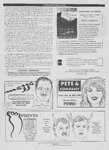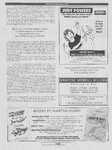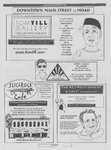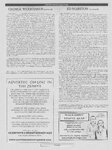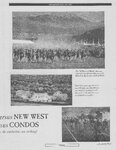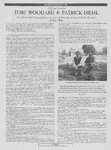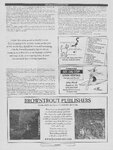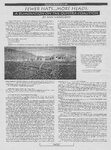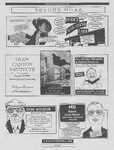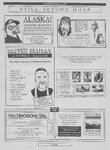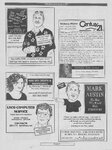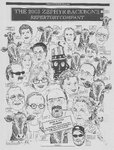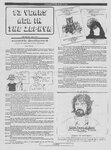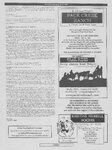| OCR Text |
Show THE GRAZING DEBATE: GEORGE A "COW-FREE WEST?" WUERTHNER SHOULD WE GROW COWS ON THE MOON? The West is a powerful place. Soaring mountains. Vast plains. Boisterous rivers. Huge spaces. But one attribute defines the West more than any other-aridity. Aridity imposes limitations and costs on human enterprises. Nowhere are the limitations and costs of aridity less apparent, yet reaping more degradation and destruction than the failed attempt to create a viable livestock industry in this dry region. Livestock production which includes not only the grazing of plants, but everything more vulnerable to predators. Most ranchers simply put their animals out on the range and allow them to fend for themselves for weeks or months at a time, giving predators plenty of opportunities for a free lunch. But in the moist East where most livestock are grazed on the back forty, one can readily monitor livestock daily and even put them in a barn or corral each night for protection. In the West, the response has been to extirpate the predators. And while in the moist East the grass two hundred yards from a stream is just as green and lush as along the waterway, in the West, nearly all green lush vegetation is concentrated in the thin green line of riparian vegetation. Here cows congregate and trample streambanks, pollute waterways. and destroy the riparian habitat that is essential to the survival of 75-80 percent of the West’s wildlife. Livestock production is responsible for more soil erosion than any other factors in the West. It is the number one source of non-point water pollution. It is the leading cause of species decline and the mayor factor in the listing of more endangered species than any other cause. In the moist East where it rains you can grow hay or other water-loving crops for animal feed without irrigation. In the West we destroy rivers by damming them, and draining them to grow hay. And so it goes. If you want to grow livestock in the West you can only do it by subsidizing the livestock operation with environmental degradation-and not surprisingly as the many federally funded irrigation projects, predator control, and other state and federally funded projects demonstrate-a great Overgrazed state land along US 191 south of Moab. deal of taxpayer money That it takes to raise a cow in the arid West including the dewatering of rivers for irrigation, the killing of predators to make the land safe for cattle, the fragmentation of landscapes with hay fields and other crops grown to fed cattle, combined with the pulverization of riparian areas under cattle hooves, and the displacement of native wildlife is by far the worse environmental catastrophe to befall the West. If this think is a bit of hyperbole consider the following. Although no full accounting of the true cost of livestock production has ever been undertaken, we do know that livestock production is responsible for more soil erosion than any other factors in the West. It is the number one source of non-point water pollution. It is the leading cause of species decline and the major factor in the listing of more endangered species than any other cause. It is the major consumer of scarce western water, and the major factor in the extirpation of many native species from the wolf to the grizzly i Most of these problems are ultimately traced to aridity and since there is little we as humans can effectively do to change the natural limitations of western geography, any proposals to make ranching somehow more benign soon run into these nonnegotiable conditions. Aridity has its cost. Low precipitation and frequent drought accounts for the West's limited productivity. In many parts of the moist and humid East one may be able to raise a cow year round on a single acre of ground. In many parts of the West 100-200 acres or more are necessary to sustain a cow. Such vast expanses require more investment, in fencing, water developments and. just time spent gathering stock. Not surprisingly Louisiana produces more beef than Wyoming-the Cowboy State. And despite the fame.of Georgia peaches and peanut, the peach state produces more cattle than Nevada. The wide open spaces that the West is famous for also means that livestock are far is not to say as well. there are not better or worse ways to ranch, and some ranchers are more conscious than others, but all must ultimately face the reality of geography. And aridity places economic limitations what ranchers can afford to spend to mitigate these problems created by geography and the use of a water-loving, slow-moving, dim-witted domestic animal as your stock. Other natural limitations derived from aridity has ecosystems themselves. Ecosystems such as the Great Palouse Prairie and others had few large grazing herds a consequence these ecosystems are not only damaged they shatter. Plants tolerate only light grazing, if at to do with western rangeland Basin, Southwest grasslands, of bison, elk, and antelope. As by cattle and sheep grazing, all. Soil crusts important for preventing soil erosion and trapping moisture are destroyed by even a small number of hooves. Weed invasion is promoted by hooves that trample plants and soils. Plus many native species simply can not compete or survive close proximity to great numbers of domestic livestock. Bighorn sheep die from alien diseases borne by domestic livestock. Other wildlife like sage grouse and desert tortoise must compete with livestock for forage and space, and have suffered a reduction in their numbers. Some animals are just persecuted to the point where their numbers have declined to brink of extinction like the wolf. Others are destroyed by hundreds of millions as pests like the black-tailed prairie dog. What is surprising about the decline of these and many other species is that they were not, for the most part, species that were scarce and of limited distribution. Rather these are animals that were so abundant that like passenger pigeon, many called them uncountable. Yet in the oe of livestock production many have fallen on hard times. One of the ways that ranchers compensate for low Sia toteriey' is by operating on huge acreages. With rising land values, this is no longer an option. There are few parts of the West where you buy ranchland and ‘pay off the mortgage rising cows. continued on page 16... WELFARE RANCHING: The Subsidized Destruction of the American West Edited By George Wuerthner and Mollie Matteson Welfare Ranching reveals the damaging practices of livestock production that are tearing apart the ecological fabric of arid western lands. A growing number of endangered species, an increase in soil erosion, water pollution, and weed — invasion are justa few of the consequences of the attempt to turn the West's | spectacular deserts, grasslands, and forests into feedlots for cattle and sheep. Livestock grazing occurs on over 300 million acres of publicly owned land, and taxpayers are footing the bill. Available from Back of Beyond Books in Moab PAGEI4 a |




